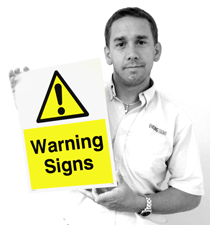Warning Hazard Signs

Are you looking for warning signs?
With so many different types of warning signs available, it can sometimes be difficult to know where to start!
The first thing you should keep in mind is that the safety signs you purchase meet BS5499 standards, so you can be sure that the items you buy will help keep you on the right side of the law.
These standards are compatible with the Health and Safety (Safety Signs and Signals) Regulations 1996. This part of the law brings into force the EC Safety Signs Directive that strives to standardise safety signs throughout the European Union.
So, if you want your visitors and employees to understand exactly what your warning signs mean, wherever they are from, make sure the ones you purchase meet BS5499 standards.
RESULTS: 584 PRODUCTS
RESULTS: 584 PRODUCTS
Why are safety signs required?
The Health and Safety Executive (HSE) has noted that in 2009-10, 121,430 injuries to employees were recorded under the Reporting of Injuries, Diseases and Dangerous Occurrence Regulations 1995.
More than five million days were also lost because of an injury in the workplace - 28.5 million overall when work-related ill health is included.
Consider the consequences if your firm was found to have broken health and safety law, or if your resources were depleted because of injured staff.
You could lose money, experience a drop in productivity and even see clients move to rivals in order to get a better service.
It is therefore important you have the right warning signs in place should you require them. Of course, your working practices need to meet HSE standards and safety signs are no replacement for this, but they can significantly bolster your risk management strategy by highlighting hazards.
Under the Health and Safety (Safety Signs and Signals) Regulations 1996, warning signs are required when risks are in place that cannot be controlled or avoided by other means.
Should the risk not be significant, or if a sign would not minimise the risk, then one is not needed. However, you need to be absolutely sure this is the case before deciding not to deploy signage.
It is good practice to invest in hazard warning signs, so if you feel their presence may prove effective, it could be the right time to make an investment.
Hazard warning signs - different types
Under BS5499 standards, warning signs have to be yellow or amber and installed at a distance that is appropriate for the situation. You won't want a massive safety sign in your small office or a smaller notice on a large building site!
There are many different types of danger signs available and they can cover areas such as chemical and substance, electrical, construction and cleaning warnings.
Construction warning signs, for example, highlight risks such as live cables being underground, trip hazards and falling debris. Cleaning notices warn people of the potential of slipping on a wet floor, while electrical danger signs provide a clear indication of high voltages and shock risks.
Danger signs tend to only show the hazard people face, rather than a call to action. This is why it is important to fully train your staff so they understand what different symbols mean and how to appropriately react.
However, dual signs are available for double the effectiveness. In the case of flagging up hazardous processes, the other half of the board can inform individuals to wear protective gear.
If this is something you like the sound of, you can also purchase ones that tell individuals to check instructions and paperwork before proceeding to handle and work with hazardous substances.
Make sure your visitors and staff are well advised and protected in the workplace with hazard warning signs.






























